China Moon Laser Breakthrough – A powerful infrared laser fired from Earth has struck a satellite orbiting the Moon in daylight, opening a new era in space communication and propulsion.

China Moon Laser Breakthrough Heralds a New Age in Space
China Moon Laser Breakthrough marks the first time a ground-based infrared laser has accurately targeted and hit a lunar satellite—Tiandu-1—from 130,000 kilometers away. Achieved in broad daylight, this milestone demonstrates optical precision previously thought impossible in space and paves the way for high-speed data links, wireless power transfer, and even laser-driven spacecraft.
China Moon Laser Breakthrough: Precision in Daylight
Hitting a small object on the Moon with a laser beam is like finding a single hair on a football field—but in space, the challenge multiplies. Sunlight interference normally drowns out laser signals, yet researchers at the Chinese Academy of Sciences fired their beam from Earth and had it reflected off Tiandu-1’s surface back to a telescope in Yunnan province in under a second. The success proves that China Moon Laser Breakthrough isn’t just hype—it’s science in action.
Goodbye Radio: Embracing Laser Communication
Traditionally, spacecraft rely on radio waves for communication. While reliable, radio is limited by bandwidth and speed. By contrast, laser beams can carry up to 100× more data, meaning faster downloads of high-resolution images, near-real-time video from lunar orbiters, and more responsive control of distant probes. With China Moon Laser Breakthrough, engineers envision a future where streaming live HD footage from Mars feels as effortless as a video call.
Why Daylight Operation Matters
Before this experiment, lasers worked best at night when the sky is dark. Daytime trials failed because the Sun’s glare overwhelmed the beam. Now, China Moon Laser Breakthrough proves lasers can cut through bright background light, enabling nearly around-the-clock communication windows. Continuous links mean fewer blackouts, better spacecraft tracking, and no more waiting for nighttime passes to send data.
Laser-Powered Propulsion: Beyond Communication
The implications of China Moon Laser Breakthrough extend far beyond sending messages. Scientists are exploring ways to use ground-based lasers as propellant engines:
-
Laser-Heated Hydrogen Thrusters
A focused laser heats hydrogen in a spacecraft’s chamber, causing it to expand and blast out a nozzle. Because the energy source is Earth-based, the craft carries minimal onboard fuel, slashing launch mass and cost. -
Laser-Driven Ion Engines
Lasers can wirelessly power solar panels on a spacecraft, which then drive efficient ion thrusters. With charged particles expelled at high velocity, these engines promise long-duration missions with far less propellant than chemical rockets. -
Laser-Pushed Solar Sails
Huge reflective sails capture the pressure of sustained laser light, gradually accelerating a craft to incredible speeds. Over months or years, these “beam-riding” vessels could explore the outer solar system—and eventually, nearby stars.
China Moon Laser Breakthrough in Action
During the experiment, technicians calibrated the infrared laser’s aim to within micro-radians—one of the smallest angular measurements used in astronomy. Despite atmospheric turbulence and daytime glare, the beam maintained focus on Tiandu-1’s retroreflector array. The prompt return signal confirmed pinpoint accuracy and showed that long-distance laser links can be both stable and repeatable.
Advantages Over Traditional Systems
-
Bandwidth & Speed:
Laser links can deliver gigabits per second, versus mere megabits over radio. -
Security & Stealth:
A tightly focused beam is hard to intercept, reducing the risk of eavesdropping. -
Weight Savings:
Eliminating heavy radio transmitters and large antennas lightens spacecraft. -
Power Delivery:
Beyond data, lasers could transmit energy, recharging satellites or powering lunar habitats.
Toward a Laser Network in Space
Building on the China Moon Laser Breakthrough, future missions may deploy a constellation of relay satellites placed between Earth and the Moon to create a continuous optical communications highway. Such a network would handle everything from routine telemetry to emergency commands, ensuring that astronauts, rovers, and landers stay seamlessly connected to mission control.
Practical Steps Ahead
To capitalize on this breakthrough, researchers plan to:
-
Scale Up Power: Increase laser output to reach Mars-orbiting spacecraft.
-
Refine Tracking: Develop adaptive optics systems that adjust in real time to atmospheric distortions.
-
Test Power Transfer: Attempt wireless energy beaming to unmanned lunar modules.
-
International Collaboration: Share findings with agencies like NASA and ESA to develop interoperable laser standards.
Global Impact of China Moon Laser Breakthrough
This achievement places China at the vanguard of a new “optical space race.” While the United States and Europe have conducted laser demos, none have succeeded in daylight at lunar distances. With China Moon Laser Breakthrough, China not only proves its technical prowess but also accelerates the timeline for next-generation space infrastructure.
Conclusion: A Bright Future Lit by Lasers
From dramatically faster data rates to futuristic propulsion concepts, the China Moon Laser Breakthrough ushers in possibilities once confined to science fiction. Within a decade, laser links may underpin everything from scientific observatories on the far side of the Moon to crewed missions on Mars. And it all started with one precisely aimed beam cutting through the bright glare of our nearest celestial neighbor.
Related: